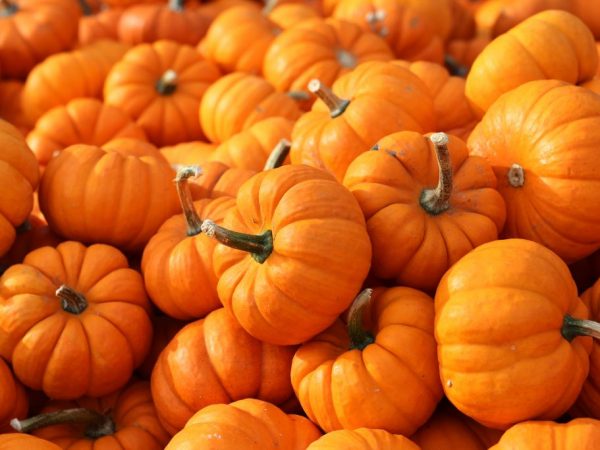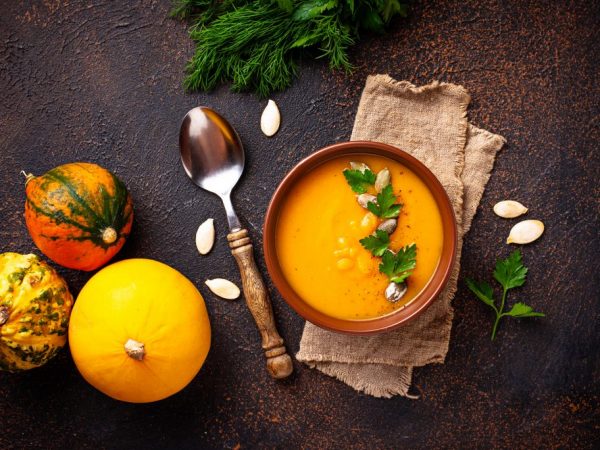Minerals and vitamins in pumpkin
Many have heard about the benefits of pumpkin, but not everyone understands what it consists of. This autumn vegetable is not just a sunny spot in the garden, but a real storehouse of valuable nutrients. Useful trace elements and vitamins in pumpkin make us healthy, help us stay slim, vigorous and active.

Minerals and vitamins in pumpkin
Rich composition
The calorie content of pumpkin depends on the variety and varies from 22 to 28 kcal per 100 g.
The leading place in the composition of the vegetable is occupied by carbohydrates - from 4 to 7 g, proteins are 1 g, and fats - 0.1 g.
The content of dietary fiber - 2 g, organic acids - 0.1 r, ash - 0.6 g, starch - 0.2 g. Average water content - 90-92 g.
Vitamins
- Pumpkin contains 9 mg of vitamin C - the first helper of immunity, a fighter against stress, aging and depression.
- The product also contains vitamin E (0.4 mg), which promotes blood circulation and preservation of youth.
- The high content of vitamins B1, B2, B3, B5, B6, B9 improves metabolic processes and liver function, rejuvenates the skin and strengthens the nervous system.
- The product contains 0.25 mg of vitamin A, which is responsible for tissue regeneration in the body.
- Pumpkin is rich in a very rare vitamin T, which reduces bad cholesterol, activates metabolism and prevents obesity.
Macro and trace elements
- The leader of the table of macronutrients contained in pumpkin is potassium (K). 100 g of the product contains 204 mg of this essential substance for the body. Potassium is essential for the functioning of the muscles and heart, the elimination of excess water, and the functioning of the nervous system.
- Pumpkin is rich in calcium (Ca) 25 mg - a mineral that affects the health of bones and teeth, as well as the correct heart rhythm.
- This vegetable contains 25 mg of phosphorus (Ph), which is responsible for the functioning of the thyroid gland and normal metabolism.
- The product contains 19 mg of chlorine (Cl), which is essential for the health of the digestive organs.
- Sulfur (S) makes up 18 mg of this vegetable and is an essential mineral for the formation of cartilage tissue.
- The content of magnesium (Mg) in pumpkin is 14 mg. This element is essential for normal sleep and a strong nervous system.
- The vegetable contains sodium (Na) - 4 mg, which regulates water-salt metabolism and blood circulation.
- Among the trace elements that complement the composition of the product: iron, zinc, iodine, fluorine, selenium, manganese, copper and others.
Seeds and oil
Pumpkin seeds are just as healthy as the pulp itself. More than a third of them are oil with valuable amino acids and proteins.
They have a high content of potassium, phosphorus, magnesium, calcium, iron, zinc, vitamins of groups C, B, E, PP. Due to the large proportion of oil, the calorie content of seeds increases to 570 kcal per 100 g, so you need to be careful with them when dieting.
Pumpkin seeds and oil normalize male sexual function due to their high zinc content. They play an important role in the treatment of the prostate gland and effectively fight parasites. And also they contain substances that poison helminths, but harmless to humans.
Consumption of seeds and pumpkin seed oil improves digestion and skin condition, creates good prevention of strokes and heart attacks.
The effect of cooking on vitamins

During the cooking process, the vegetable loses half of its nutrients.
Unfortunately, losses of valuable substances are inevitable during the cooking process. So, in the composition of boiled pumpkin, the amount of vitamin C is almost 2 times less than in raw pumpkin. The share of vitamins A, B, E, PP also decreases by almost a third. Oddly enough, but for their preservation, quick frying will be much more beneficial than cooking. Steam cooking is the most effective way to save nutrients.
If you still need to boil the pumpkin, try to do it correctly - under a tightly closed lid and without adding cold water.
As for valuable microelements, many of them dissolve well in water and turn into broth during cooking. Therefore, cooking is more justified when cooking liquid dishes, for which you do not need to drain the water.
Beneficial features
Raw pumpkin or pumpkin juice is often used to supply carotene to the body. It helps to normalize metabolism and promotes a diuretic effect.
Pumpkin juice is recommended to drink for diseases of the heart and liver. Outwardly, it is used in compresses for the treatment of burns and dermatitis. With periodontitis, you can rinse the mouth with juice.
Recent studies have shown that this product creates prevention and aids in the treatment of cancer, especially lung cancer.
Pumpkin is often included in the diet for gastritis and gallbladder diseases. It is indispensable for weight loss, since it allows you to regulate metabolism, reduces appetite, has a high nutritional value and low calorie content.
In home cosmetology, pulp is often used for nourishing masks, and crushed seeds are often used to restore hair health.
Harm and contraindications
This product contains a significant proportion of sugar, so it should be limited when blood sugar levels are elevated (especially raw).
Also, contraindications apply to some diseases of the digestive system: ulcers, intestinal colic, gastritis with low acidity. Health hazard can be caused by abuse of the product. For example, pumpkin juice is indicated for consumption in moderation - no more than two glasses a day to avoid diarrhea.
Do not forget about the risk of nitrate poisoning if you buy pumpkin in a store or market, and do not grow it yourself. This product does not belong to vegetables that intensively accumulate nitrates, but it still absorbs them, albeit at an average level. Boiling the vegetable helps to partially get rid of nitrates.
Conclusion
Pumpkin is rich in vitamins and minerals that our body needs. Valuable substances are found not only in the pulp, but also in the seeds of the vegetable.
A diet with its participation promotes recovery from many diseases, and contraindications to this product are minimal.

